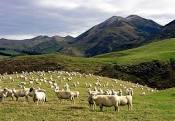New Zealand lamb is about to be exported to Iran for the first time in decades
New Zealand is about to resume shipments of lamb to Iran, after a gap of two decades. On May 22 Wellington processor Taylor Preston will ship a modest 60 tonnes of frozen cuts to mark the resumption of the trade.
Taylor Preston chief executive Simon Gatenby said the company was looking to do more business with Iran.

A worker processes lamb for export to Iran at the Taylor Preston plant in Wellington.
“The reason we’re doing this is to develop the trade, it’s a nice easy order to start with, it allows us to get a bit of volume into the market and allow it to be tested.”
Farmers supplying the late season lambs were being paid a premium of $6.10 per kilogram.
Ayatollah Khomeini in Tehran on his return from exile in 1979. Later in the year he met with a New Zealand delegation and subsequently the meat trade burgeoned.
New Zealand’s largest meat processing company Silver Fern Farms is in talks with Iranian officials, but shipments are not likely until the new season.
The trade was in its heyday in the 1980s when there were 22 sheep for every Kiwi, and high volume markets were desperately needed. Back then Iran took more than 100,000 tonnes of frozen carcasses a year, or one lamb in four.
The renewed trade follows a February visit by Primary Industries Minister Nathan Guy who signed a veterinary agreement to enable chilled and frozen lamb and beef exports to the Islamic Republic.

Workers divide a carcass into six for the Iranian market.
Relations have warmed since international sanctions against Tehran were eased after an accord was reached in 2015 on Iran’s nuclear programme, at a time when New Zealand held the rotating presidency

of the United Nations Security Council.
Gatenby said the lamb would be sold for retail and domestic consumption.
“We’ve sold the Iranians essentially a full carcass but we’ve broken it into six main primal cuts – two legs, two loins and two shoulders,” Gatenby said.
“Currently some 25 per cent of our exports are halal certified, of which around one-third is destined for the Muslim countries in the Middle East and Asia where it is a condition of market access; and the other two-thirds is destined for Muslim customers in non-Muslim countries – such as China.”
Ritchie said when he visited Iran with the minister, Iranian officials and businesses were “very keen” to do trade with New Zealand.

Lamb exports to Iran 1975-98.
“They import around 100,000 tonnes of red meat a year – 10 per cent of their consumption. The great majority of those imports are beef from Brazil and they are therefore keen to lift the lamb component.”
Iran was a significant market of nearly 80 million people. Because New Zealand meat marketing is now much more diversified, exporting to 120 countries, the trade would not reach the levels it used to.
In the 1970s and 1980s New Zealand exporters and officials had to navigate difficult political waters as they negotiated trade deals.
In 1979, the year of the Iranian revolution, Ayatollah Khomeini agreed to meet a New Zealand delegation which wanted to assure the Iranians that it could guarantee halal meat.
“The Ayatollah looked frail and tired, but his eyes had great power,” observed the Meat Board’s marketing manager John Stoddart.
The deal foundered in the mid-80s as the oil-rich country insisted on paying for the lamb in barrels of oil but for a short time the trade was a lifesaver for the meat industry.
It finally petered out in 1998 as sheep numbers and production dropped, other markets were paying better prices (Europe, North America), and more emphasis was going in to producing cuts (frozen, then chilled) rather than carcasses.
– Stuff


